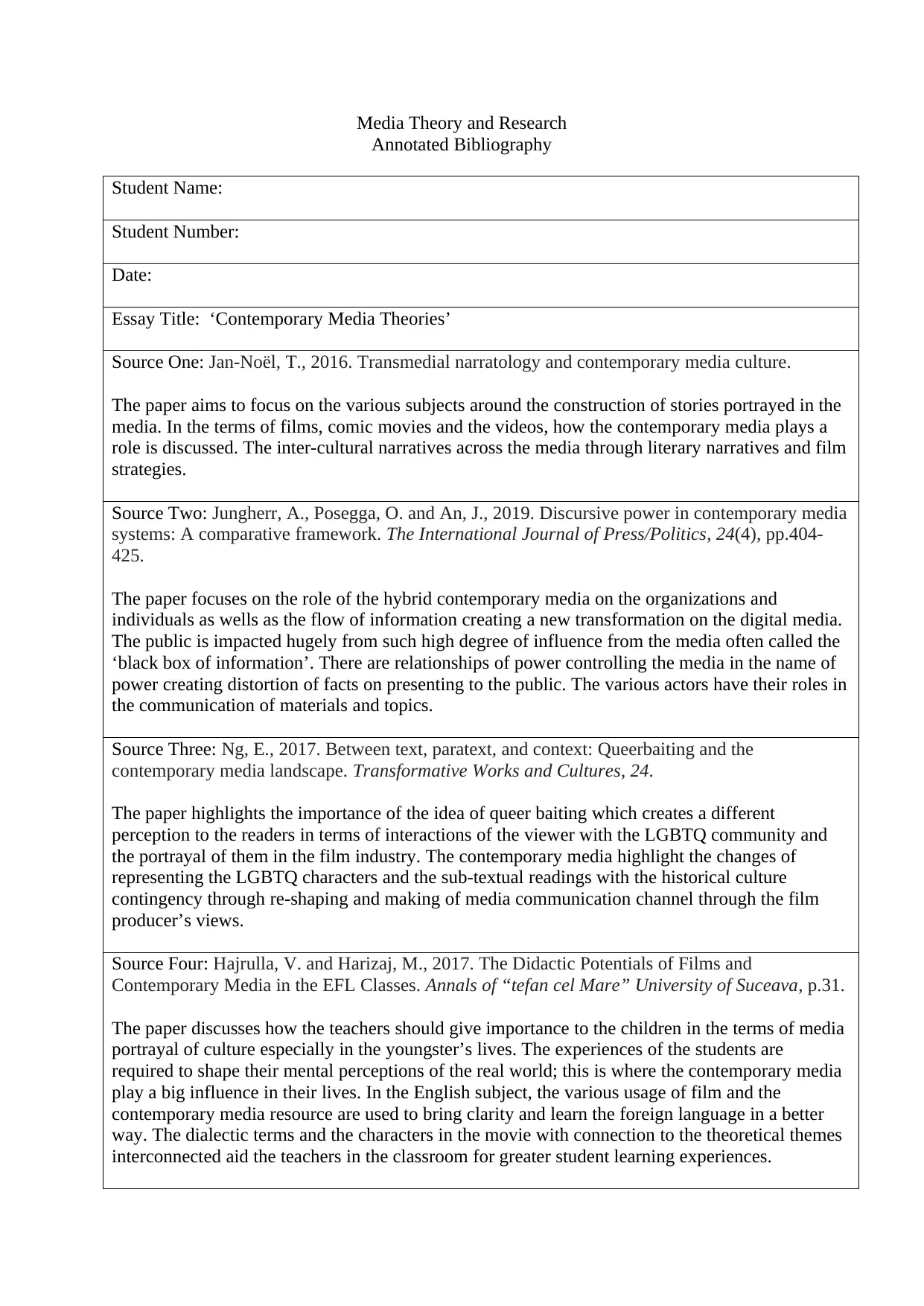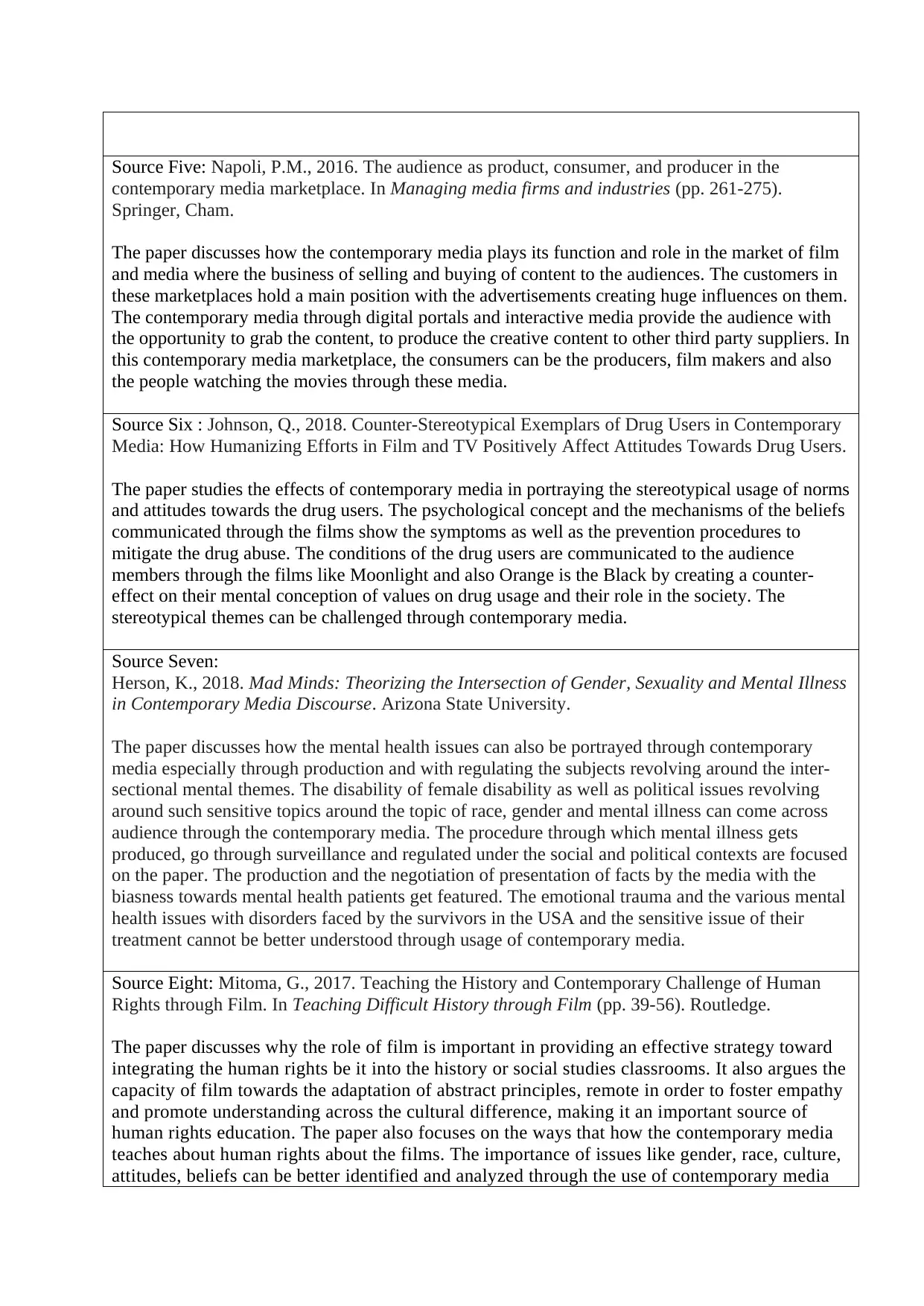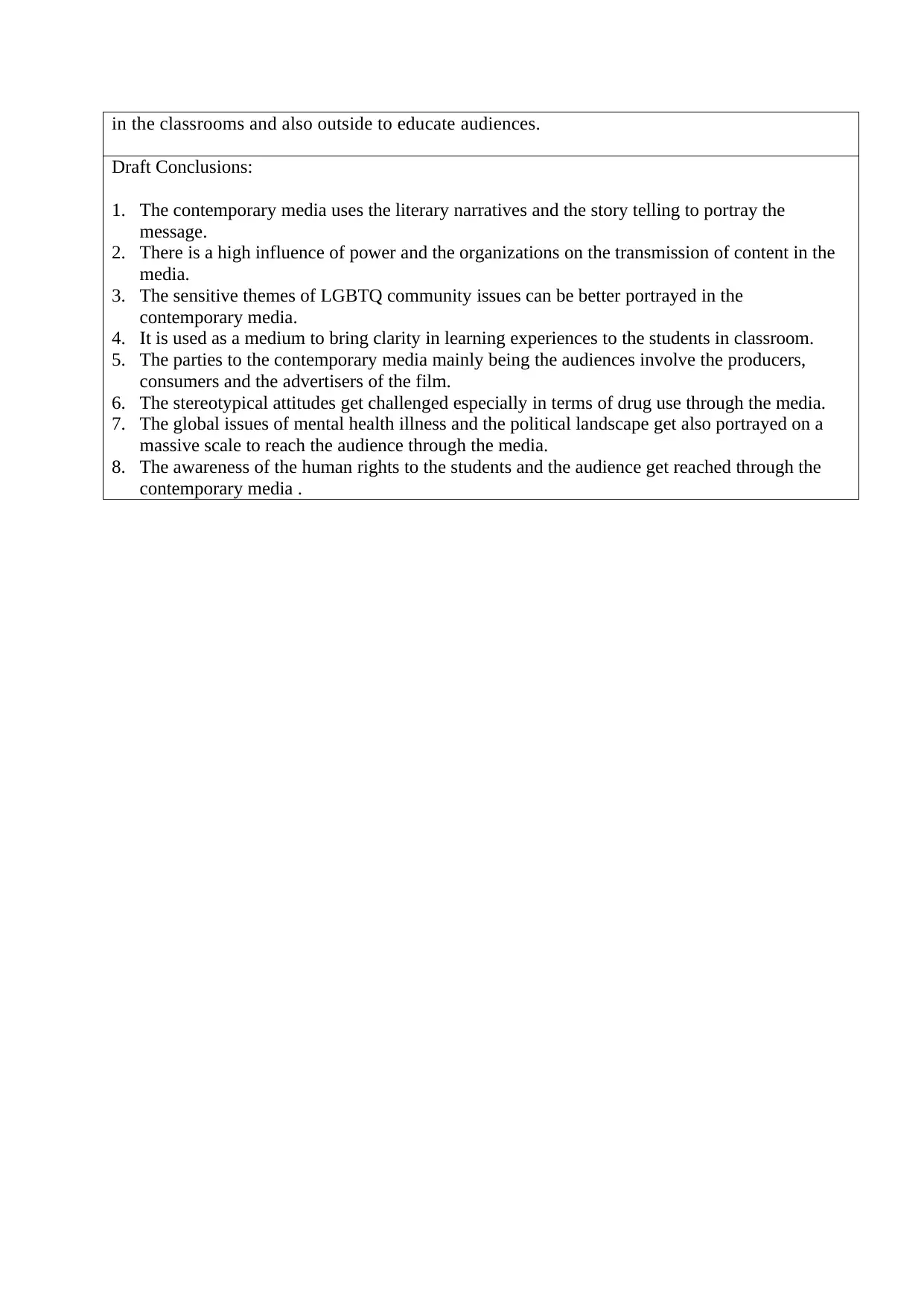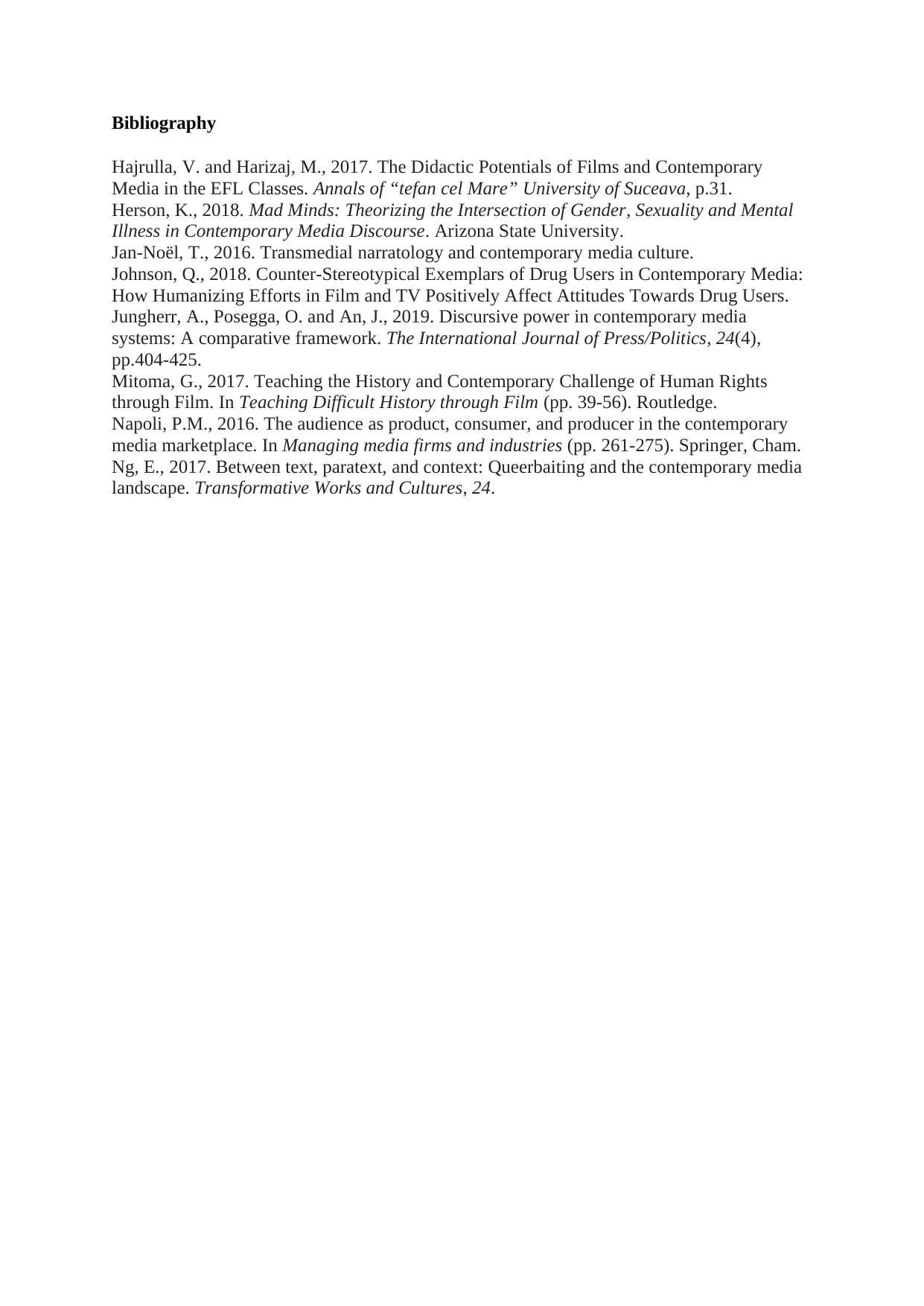Annotated Bibliography: Contemporary Media Theories and Research
VerifiedAdded on 2022/08/21
|4
|1505
|38
Annotated Bibliography
AI Summary
This annotated bibliography examines eight sources related to contemporary media theories and research. The sources cover a range of topics, including transmedial narratology, discursive power in media systems, queerbaiting, the use of media in education, the audience's role in the media marketplace, the portrayal of drug users, the representation of mental illness, and the use of film in teaching human rights. The bibliography highlights how media shapes narratives, influences public perception, addresses social issues, and impacts education. The sources discuss the power dynamics within media, the challenges of representing marginalized groups, and the potential of media to promote understanding and empathy. The student has compiled this bibliography to provide a comprehensive overview of key themes and research in the field of contemporary media studies. This assignment is published on Desklib, a platform providing AI-based study tools for students.

Media Theory and Research
Annotated Bibliography
Student Name:
Student Number:
Date:
Essay Title: ‘Contemporary Media Theories’
Source One: Jan-Noël, T., 2016. Transmedial narratology and contemporary media culture.
The paper aims to focus on the various subjects around the construction of stories portrayed in the
media. In the terms of films, comic movies and the videos, how the contemporary media plays a
role is discussed. The inter-cultural narratives across the media through literary narratives and film
strategies.
Source Two: Jungherr, A., Posegga, O. and An, J., 2019. Discursive power in contemporary media
systems: A comparative framework. The International Journal of Press/Politics, 24(4), pp.404-
425.
The paper focuses on the role of the hybrid contemporary media on the organizations and
individuals as wells as the flow of information creating a new transformation on the digital media.
The public is impacted hugely from such high degree of influence from the media often called the
‘black box of information’. There are relationships of power controlling the media in the name of
power creating distortion of facts on presenting to the public. The various actors have their roles in
the communication of materials and topics.
Source Three: Ng, E., 2017. Between text, paratext, and context: Queerbaiting and the
contemporary media landscape. Transformative Works and Cultures, 24.
The paper highlights the importance of the idea of queer baiting which creates a different
perception to the readers in terms of interactions of the viewer with the LGBTQ community and
the portrayal of them in the film industry. The contemporary media highlight the changes of
representing the LGBTQ characters and the sub-textual readings with the historical culture
contingency through re-shaping and making of media communication channel through the film
producer’s views.
Source Four: Hajrulla, V. and Harizaj, M., 2017. The Didactic Potentials of Films and
Contemporary Media in the EFL Classes. Annals of “tefan cel Mare” University of Suceava, p.31.
The paper discusses how the teachers should give importance to the children in the terms of media
portrayal of culture especially in the youngster’s lives. The experiences of the students are
required to shape their mental perceptions of the real world; this is where the contemporary media
play a big influence in their lives. In the English subject, the various usage of film and the
contemporary media resource are used to bring clarity and learn the foreign language in a better
way. The dialectic terms and the characters in the movie with connection to the theoretical themes
interconnected aid the teachers in the classroom for greater student learning experiences.
Annotated Bibliography
Student Name:
Student Number:
Date:
Essay Title: ‘Contemporary Media Theories’
Source One: Jan-Noël, T., 2016. Transmedial narratology and contemporary media culture.
The paper aims to focus on the various subjects around the construction of stories portrayed in the
media. In the terms of films, comic movies and the videos, how the contemporary media plays a
role is discussed. The inter-cultural narratives across the media through literary narratives and film
strategies.
Source Two: Jungherr, A., Posegga, O. and An, J., 2019. Discursive power in contemporary media
systems: A comparative framework. The International Journal of Press/Politics, 24(4), pp.404-
425.
The paper focuses on the role of the hybrid contemporary media on the organizations and
individuals as wells as the flow of information creating a new transformation on the digital media.
The public is impacted hugely from such high degree of influence from the media often called the
‘black box of information’. There are relationships of power controlling the media in the name of
power creating distortion of facts on presenting to the public. The various actors have their roles in
the communication of materials and topics.
Source Three: Ng, E., 2017. Between text, paratext, and context: Queerbaiting and the
contemporary media landscape. Transformative Works and Cultures, 24.
The paper highlights the importance of the idea of queer baiting which creates a different
perception to the readers in terms of interactions of the viewer with the LGBTQ community and
the portrayal of them in the film industry. The contemporary media highlight the changes of
representing the LGBTQ characters and the sub-textual readings with the historical culture
contingency through re-shaping and making of media communication channel through the film
producer’s views.
Source Four: Hajrulla, V. and Harizaj, M., 2017. The Didactic Potentials of Films and
Contemporary Media in the EFL Classes. Annals of “tefan cel Mare” University of Suceava, p.31.
The paper discusses how the teachers should give importance to the children in the terms of media
portrayal of culture especially in the youngster’s lives. The experiences of the students are
required to shape their mental perceptions of the real world; this is where the contemporary media
play a big influence in their lives. In the English subject, the various usage of film and the
contemporary media resource are used to bring clarity and learn the foreign language in a better
way. The dialectic terms and the characters in the movie with connection to the theoretical themes
interconnected aid the teachers in the classroom for greater student learning experiences.
Paraphrase This Document
Need a fresh take? Get an instant paraphrase of this document with our AI Paraphraser

Source Five: Napoli, P.M., 2016. The audience as product, consumer, and producer in the
contemporary media marketplace. In Managing media firms and industries (pp. 261-275).
Springer, Cham.
The paper discusses how the contemporary media plays its function and role in the market of film
and media where the business of selling and buying of content to the audiences. The customers in
these marketplaces hold a main position with the advertisements creating huge influences on them.
The contemporary media through digital portals and interactive media provide the audience with
the opportunity to grab the content, to produce the creative content to other third party suppliers. In
this contemporary media marketplace, the consumers can be the producers, film makers and also
the people watching the movies through these media.
Source Six : Johnson, Q., 2018. Counter-Stereotypical Exemplars of Drug Users in Contemporary
Media: How Humanizing Efforts in Film and TV Positively Affect Attitudes Towards Drug Users.
The paper studies the effects of contemporary media in portraying the stereotypical usage of norms
and attitudes towards the drug users. The psychological concept and the mechanisms of the beliefs
communicated through the films show the symptoms as well as the prevention procedures to
mitigate the drug abuse. The conditions of the drug users are communicated to the audience
members through the films like Moonlight and also Orange is the Black by creating a counter-
effect on their mental conception of values on drug usage and their role in the society. The
stereotypical themes can be challenged through contemporary media.
Source Seven:
Herson, K., 2018. Mad Minds: Theorizing the Intersection of Gender, Sexuality and Mental Illness
in Contemporary Media Discourse. Arizona State University.
The paper discusses how the mental health issues can also be portrayed through contemporary
media especially through production and with regulating the subjects revolving around the inter-
sectional mental themes. The disability of female disability as well as political issues revolving
around such sensitive topics around the topic of race, gender and mental illness can come across
audience through the contemporary media. The procedure through which mental illness gets
produced, go through surveillance and regulated under the social and political contexts are focused
on the paper. The production and the negotiation of presentation of facts by the media with the
biasness towards mental health patients get featured. The emotional trauma and the various mental
health issues with disorders faced by the survivors in the USA and the sensitive issue of their
treatment cannot be better understood through usage of contemporary media.
Source Eight: Mitoma, G., 2017. Teaching the History and Contemporary Challenge of Human
Rights through Film. In Teaching Difficult History through Film (pp. 39-56). Routledge.
The paper discusses why the role of film is important in providing an effective strategy toward
integrating the human rights be it into the history or social studies classrooms. It also argues the
capacity of film towards the adaptation of abstract principles, remote in order to foster empathy
and promote understanding across the cultural difference, making it an important source of
human rights education. The paper also focuses on the ways that how the contemporary media
teaches about human rights about the films. The importance of issues like gender, race, culture,
attitudes, beliefs can be better identified and analyzed through the use of contemporary media
contemporary media marketplace. In Managing media firms and industries (pp. 261-275).
Springer, Cham.
The paper discusses how the contemporary media plays its function and role in the market of film
and media where the business of selling and buying of content to the audiences. The customers in
these marketplaces hold a main position with the advertisements creating huge influences on them.
The contemporary media through digital portals and interactive media provide the audience with
the opportunity to grab the content, to produce the creative content to other third party suppliers. In
this contemporary media marketplace, the consumers can be the producers, film makers and also
the people watching the movies through these media.
Source Six : Johnson, Q., 2018. Counter-Stereotypical Exemplars of Drug Users in Contemporary
Media: How Humanizing Efforts in Film and TV Positively Affect Attitudes Towards Drug Users.
The paper studies the effects of contemporary media in portraying the stereotypical usage of norms
and attitudes towards the drug users. The psychological concept and the mechanisms of the beliefs
communicated through the films show the symptoms as well as the prevention procedures to
mitigate the drug abuse. The conditions of the drug users are communicated to the audience
members through the films like Moonlight and also Orange is the Black by creating a counter-
effect on their mental conception of values on drug usage and their role in the society. The
stereotypical themes can be challenged through contemporary media.
Source Seven:
Herson, K., 2018. Mad Minds: Theorizing the Intersection of Gender, Sexuality and Mental Illness
in Contemporary Media Discourse. Arizona State University.
The paper discusses how the mental health issues can also be portrayed through contemporary
media especially through production and with regulating the subjects revolving around the inter-
sectional mental themes. The disability of female disability as well as political issues revolving
around such sensitive topics around the topic of race, gender and mental illness can come across
audience through the contemporary media. The procedure through which mental illness gets
produced, go through surveillance and regulated under the social and political contexts are focused
on the paper. The production and the negotiation of presentation of facts by the media with the
biasness towards mental health patients get featured. The emotional trauma and the various mental
health issues with disorders faced by the survivors in the USA and the sensitive issue of their
treatment cannot be better understood through usage of contemporary media.
Source Eight: Mitoma, G., 2017. Teaching the History and Contemporary Challenge of Human
Rights through Film. In Teaching Difficult History through Film (pp. 39-56). Routledge.
The paper discusses why the role of film is important in providing an effective strategy toward
integrating the human rights be it into the history or social studies classrooms. It also argues the
capacity of film towards the adaptation of abstract principles, remote in order to foster empathy
and promote understanding across the cultural difference, making it an important source of
human rights education. The paper also focuses on the ways that how the contemporary media
teaches about human rights about the films. The importance of issues like gender, race, culture,
attitudes, beliefs can be better identified and analyzed through the use of contemporary media

in the classrooms and also outside to educate audiences.
Draft Conclusions:
1. The contemporary media uses the literary narratives and the story telling to portray the
message.
2. There is a high influence of power and the organizations on the transmission of content in the
media.
3. The sensitive themes of LGBTQ community issues can be better portrayed in the
contemporary media.
4. It is used as a medium to bring clarity in learning experiences to the students in classroom.
5. The parties to the contemporary media mainly being the audiences involve the producers,
consumers and the advertisers of the film.
6. The stereotypical attitudes get challenged especially in terms of drug use through the media.
7. The global issues of mental health illness and the political landscape get also portrayed on a
massive scale to reach the audience through the media.
8. The awareness of the human rights to the students and the audience get reached through the
contemporary media .
Draft Conclusions:
1. The contemporary media uses the literary narratives and the story telling to portray the
message.
2. There is a high influence of power and the organizations on the transmission of content in the
media.
3. The sensitive themes of LGBTQ community issues can be better portrayed in the
contemporary media.
4. It is used as a medium to bring clarity in learning experiences to the students in classroom.
5. The parties to the contemporary media mainly being the audiences involve the producers,
consumers and the advertisers of the film.
6. The stereotypical attitudes get challenged especially in terms of drug use through the media.
7. The global issues of mental health illness and the political landscape get also portrayed on a
massive scale to reach the audience through the media.
8. The awareness of the human rights to the students and the audience get reached through the
contemporary media .
⊘ This is a preview!⊘
Do you want full access?
Subscribe today to unlock all pages.

Trusted by 1+ million students worldwide

Bibliography
Hajrulla, V. and Harizaj, M., 2017. The Didactic Potentials of Films and Contemporary
Media in the EFL Classes. Annals of “tefan cel Mare” University of Suceava, p.31.
Herson, K., 2018. Mad Minds: Theorizing the Intersection of Gender, Sexuality and Mental
Illness in Contemporary Media Discourse. Arizona State University.
Jan-Noël, T., 2016. Transmedial narratology and contemporary media culture.
Johnson, Q., 2018. Counter-Stereotypical Exemplars of Drug Users in Contemporary Media:
How Humanizing Efforts in Film and TV Positively Affect Attitudes Towards Drug Users.
Jungherr, A., Posegga, O. and An, J., 2019. Discursive power in contemporary media
systems: A comparative framework. The International Journal of Press/Politics, 24(4),
pp.404-425.
Mitoma, G., 2017. Teaching the History and Contemporary Challenge of Human Rights
through Film. In Teaching Difficult History through Film (pp. 39-56). Routledge.
Napoli, P.M., 2016. The audience as product, consumer, and producer in the contemporary
media marketplace. In Managing media firms and industries (pp. 261-275). Springer, Cham.
Ng, E., 2017. Between text, paratext, and context: Queerbaiting and the contemporary media
landscape. Transformative Works and Cultures, 24.
Hajrulla, V. and Harizaj, M., 2017. The Didactic Potentials of Films and Contemporary
Media in the EFL Classes. Annals of “tefan cel Mare” University of Suceava, p.31.
Herson, K., 2018. Mad Minds: Theorizing the Intersection of Gender, Sexuality and Mental
Illness in Contemporary Media Discourse. Arizona State University.
Jan-Noël, T., 2016. Transmedial narratology and contemporary media culture.
Johnson, Q., 2018. Counter-Stereotypical Exemplars of Drug Users in Contemporary Media:
How Humanizing Efforts in Film and TV Positively Affect Attitudes Towards Drug Users.
Jungherr, A., Posegga, O. and An, J., 2019. Discursive power in contemporary media
systems: A comparative framework. The International Journal of Press/Politics, 24(4),
pp.404-425.
Mitoma, G., 2017. Teaching the History and Contemporary Challenge of Human Rights
through Film. In Teaching Difficult History through Film (pp. 39-56). Routledge.
Napoli, P.M., 2016. The audience as product, consumer, and producer in the contemporary
media marketplace. In Managing media firms and industries (pp. 261-275). Springer, Cham.
Ng, E., 2017. Between text, paratext, and context: Queerbaiting and the contemporary media
landscape. Transformative Works and Cultures, 24.
1 out of 4
Related Documents
Your All-in-One AI-Powered Toolkit for Academic Success.
+13062052269
info@desklib.com
Available 24*7 on WhatsApp / Email
![[object Object]](/_next/static/media/star-bottom.7253800d.svg)
Unlock your academic potential
Copyright © 2020–2025 A2Z Services. All Rights Reserved. Developed and managed by ZUCOL.





